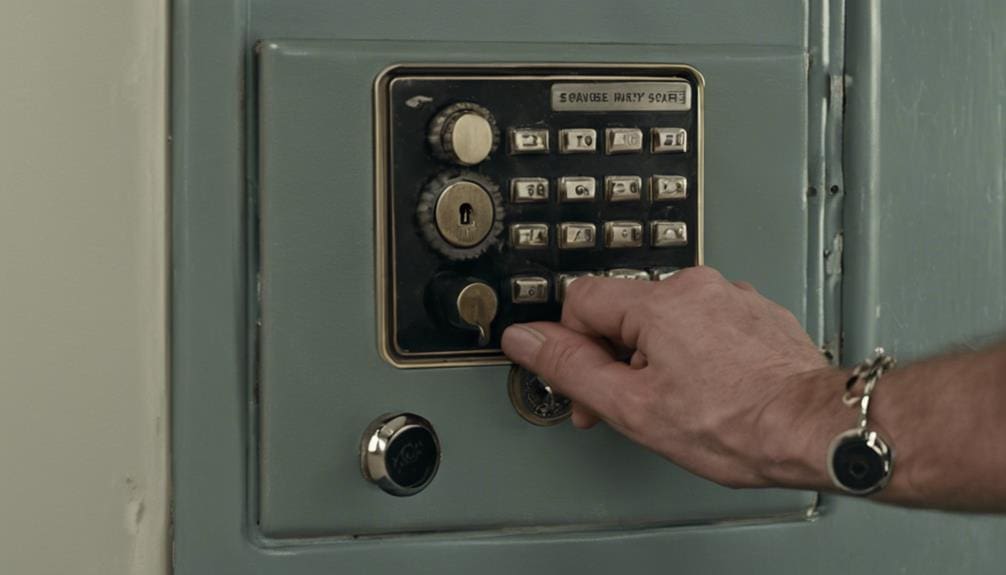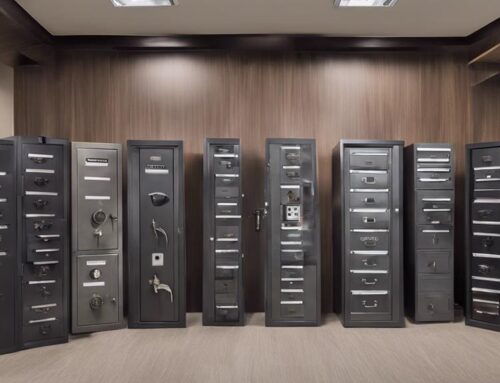To alter your safe’s combination, begin by holding the door open. For mechanical locks, utilize the modification key and refer to your owner’s manual. Find the keyhole at the lock’s rear and test the fresh code before shutting. For electronic locks, input the existing code, enter change mode, and establish a new code. Utilize Super Code or Manager Code for convenience. Always verify the fresh combination with the door ajar to prevent being locked out. In certain situations, professional locksmiths are necessary, particularly if you’re uncertain about the procedure. Learn more for a smooth and secure combination adjustment.
Key Takeaways
- Always keep the safe door open when changing the combination to avoid lockout.
- For mechanical safes, ensure you have the change key and follow the owner’s manual for specific instructions.
- For electronic safes, begin the process by inputting the current code and follow the guided steps to set a new code.
- Test the new combination multiple times with the safe door open to ensure it works correctly.
- Consult a professional locksmith if you encounter issues or lack the necessary tools for changing the combination.
Mechanical Safe Lock Combination Change
To alter the combination on a mechanical safe lock, first make certain you have the alteration key and the safe’s owner’s manual on hand. Begin by thoroughly reading the owner’s manual, as it provides specific instructions tailored to your lock model. Next, open the safe door and leave it open during the entire process to prevent accidental lockouts.
Locate the alteration keyhole, usually found on the back of the lock mechanism. Insert the alteration key into this keyhole. Rotate the alteration key as directed in the manual, often turning it 90 degrees in a specific direction.
Now, dial the existing combination to clear the lock. Follow the manual’s instructions to set a new combination. This typically involves turning the dial in a precise sequence to encode your new combination. Once you’ve set the new combination, turn the alteration key back to its original position and remove it.
Before closing the safe door, test the new combination several times to verify it works correctly. If you’re unsure at any step or encounter issues, it’s wise to seek assistance from a professional locksmith to avoid potential problems.
Electronic Safe Lock Combination Change
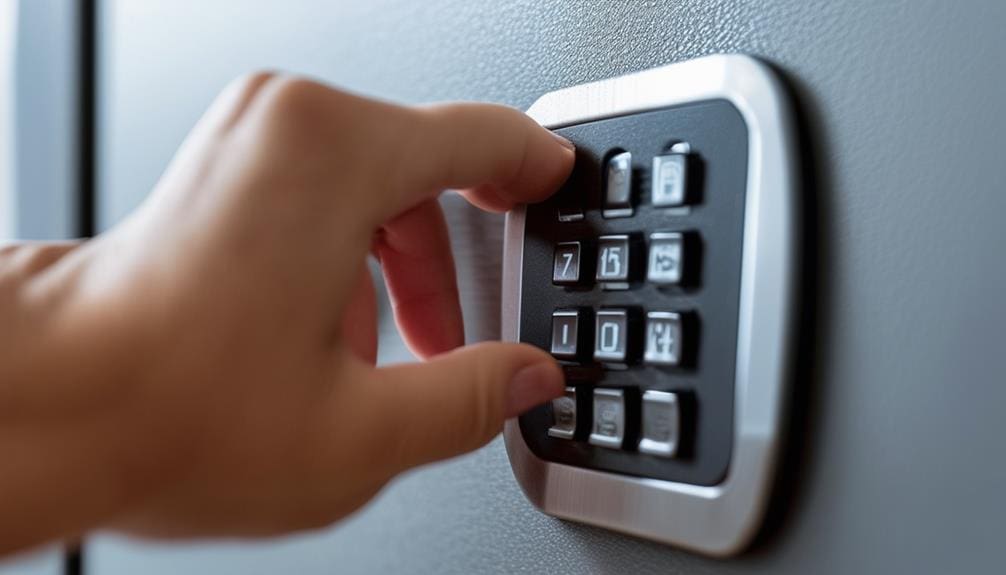
Switching gears from mechanical to electronic, changing the combination on an electronic safe lock, such as the SecuRam ProLogic L01, begins by pressing specific keys to input the current code. The process is user-friendly and designed to provide clear, guided steps.
- Input Current Code: First, enter your existing code. This step usually includes pressing a specific key, like the ‘0’ or ‘Enter’ button, followed by the current combination. Audible and visual cues will confirm you’ve entered it correctly.
- Access Change Mode: Once the current code is accepted, you’ll need to access the combination change mode. For the SecuRam ProLogic L01, this often involves pressing and holding a combination of keys, like ‘0’ and ‘1’ simultaneously, until you see a specific indicator light up.
- Set New Code: Now, input your new code. Make sure it’s something secure and memorable. You’ll likely need to repeat this code to confirm it. Visual and audible signals will again guide you through this step to ensure precision.
Having a Super Code or Manager Code can make this even simpler, providing an extra layer of convenience. With these precise instructions, you’ll find changing your electronic safe lock combination straightforward and secure.
Benefits of Electronic Safe Locks
When selecting an electronic safe lock, you’ll benefit from the straightforward process of changing combinations. Unlike mechanical locks, electronic safes, like the SecuRam TopLit and BackLit models, offer simple-to-follow steps that make the combination change process much easier. The ProLogic L01 electronic lock, for example, guides you through the combination changes with a display screen, guaranteeing precision and ease.
Upgrading to an electronic safe lock means you’ll no longer need to struggle with intricate mechanical procedures. Instead, you’ll find that electronic safes often require just a few button presses to update your combination. The Super Code or Manager Code can further streamline this process, allowing you to make changes without hassle.
To change the combination on an electronic safe, you’ll typically enter the existing code, followed by the Super Code or Manager Code. Then, you can input the new combination. This user-friendly approach ensures that even those unfamiliar with safes can manage their security settings effectively.
Precautions Before Changing Combinations
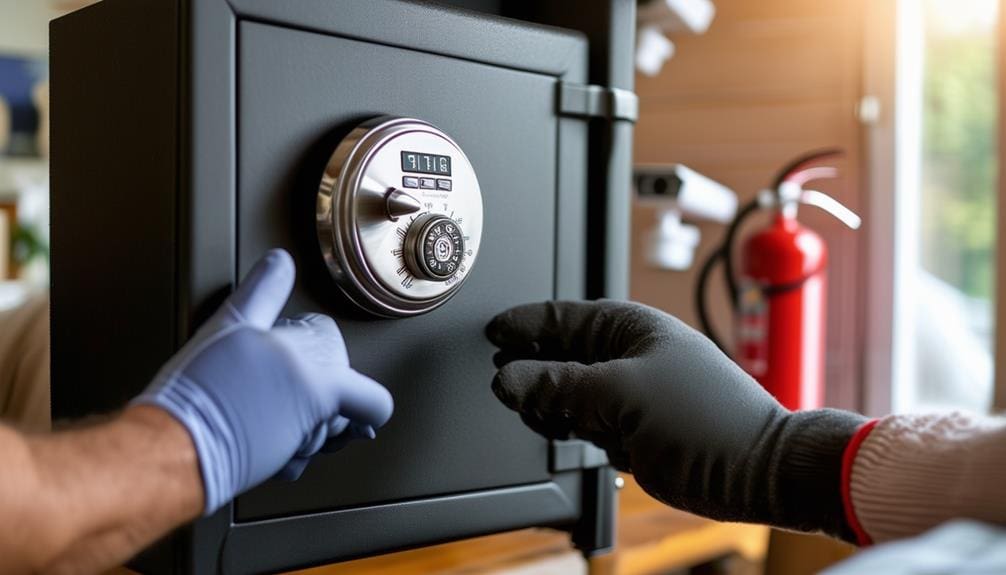
Before you alter the combination on your safe, make certain you consult the safe’s manual for specific instructions to avoid any errors. Following the manufacturer’s instructions is vital for a smooth and successful combination change.
To make sure a proper and safe process, follow these essential precautions:
- Keep the Safe Door Open: Always perform the combination change with the safe door open. This prevents accidental lockouts, ensuring you can still access your valuables if something goes wrong during the process.
- Use the Change Key: For mechanical safes, you’ll need a change key to modify the combination. Make sure you have this key ready before starting. If you don’t have the change key, contact the safe dealer or a locksmith for assistance.
- Double-Check the New Combination: Before finalizing the new combination, double-check that it works correctly with the safe door open. This step verifies that the new combination is set accurately and that you won’t face issues locking the safe.
When to Seek Professional Help
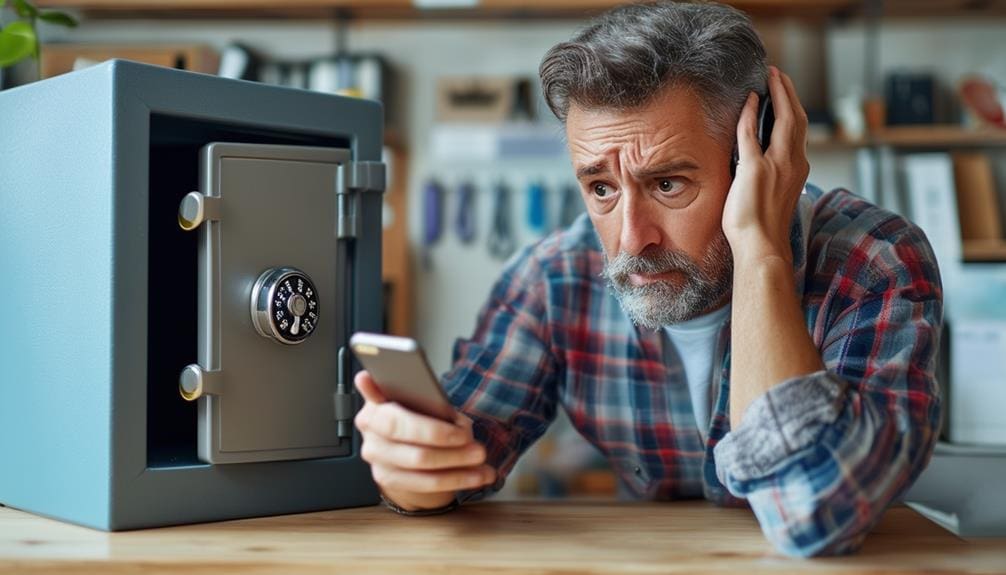
If you’ve misplaced the change key or lack the necessary tools and knowledge, it’s wise to seek professional assistance to alter the combination on your safe. Attempting to modify the combination without these essentials can result in lockouts or damage. Locksmith services are equipped to handle such tasks, especially for mechanical locks.
First, identify a reputable locksmith service with years of experience in dealing with safes. A professional locksmith will have the precision tools required to alter the combination correctly. Always prioritize safety and efficiency; putting your safe first ensures your valuables are secure.
When dealing with mechanical locks, expertise is vital. Professionals know the intricate workings of these locks and can make changes without causing harm. They also provide guidance to prevent future issues.
For electronic locks, professional help is even more essential. If you encounter any issues during the process, a skilled locksmith can troubleshoot and resolve them efficiently.
Frequently Asked Questions
How to Change Safe Combination Lock?
To change your safe combination lock, follow these steps: perform safe combination troubleshooting, maintain safe lock regularly, and consider upgrading for improved safe security. For accurate safe lock installation, use precision tools and keep the door open.
How to Change a Combination Lock Code?
Oh, changing a master lock code? It’s a breeze! Start by setting your new code, then adjust the dial settings precisely. Don’t forget, updating the passcode on a mechanical lock might need precision tools and thorough explanations.
How to Reset a Combination Lock 4 Digit?
To reset a 4-digit combination lock, find the Master lock reset button or pinhole. Follow instructions carefully, considering security. If unsure, seek locksmith assistance. Explore various combination lock options to enhance your security measures.
How to Reset Sentry Safe Dial Combination?
To reset your Sentry Safe dial combination, open the safe, locate the reset button, and use the factory code. For troubleshooting common issues, memorize new combinations, perform regular maintenance, and enhance security by keeping your code confidential.
Conclusion
Changing your safe’s combination, whether mechanical or electronic, isn’t just a task—it’s a way to guarantee your peace of mind. By taking the right precautions and knowing when to seek professional help, you’re safeguarding your valuables. Think of this process as a puzzle that, once solved, grants you the ultimate security. So, follow the steps, use precision tools, and you’ll access a new level of protection for your home.

